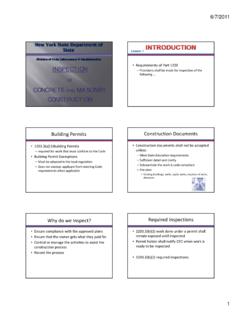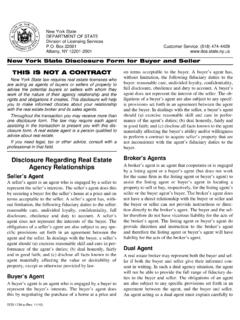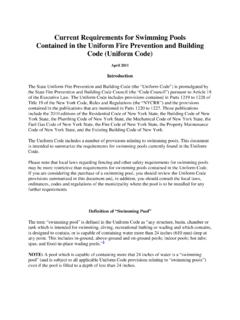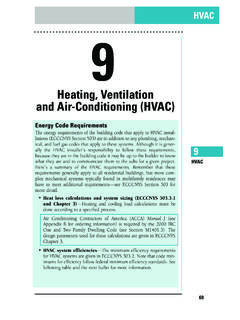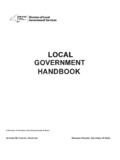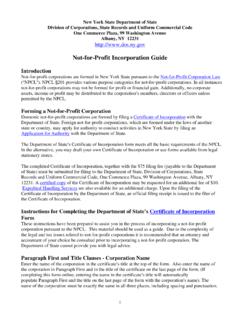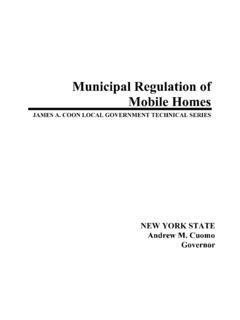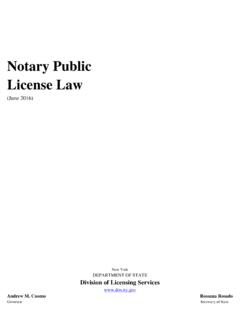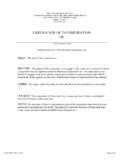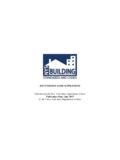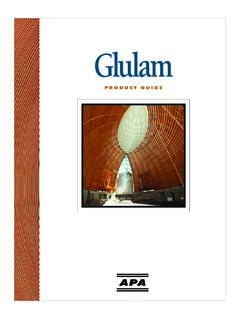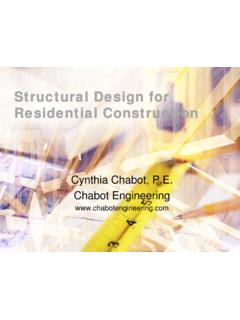Transcription of INSPECTION CONCRETE AND MASONRY CONSTRUCTION
1 6/7/2011. Lesson 1. Requirements of Part 1203. INSPECTION Provisions shall be made for INSPECTION of the following . OF. CONCRETE AND MASONRY . CONSTRUCTION . Building Permits CONSTRUCTION Documents (a)(1)Building Permits CONSTRUCTION documents shall not be accepted required for work that must conform to the Code unless: Building Permit Exemptions Meet State Education requirements Must be adopted in the local regulation Sufficient detail and clarity Does not exempt applicant from meeting Code Substantiate the work is code compliant requirements when applicable Site plan Existing buildings, wells, septic tanks, location of work, distances Why do we Inspect? Required Inspections Ensure compliance with the approved plans (b)(1) work done under a permit shall Ensure that the owner gets what they paid for remain exposed until inspected Control or manage the activities to assist the Permit holder shall notify CEO when work is CONSTRUCTION i process ready to be inspected Record the process (b)(2) required inspections: 1.
2 6/7/2011. CONSTRUCTION Inspections Site prior to issuing the permit Provisions shall be made for INSPECTION of the following . (i) work site prior to the issuance of a permit;. (ii) footing and foundation;. (iii) preparation for CONCRETE slab;. (iv) framing;. (v) building systems, including underground and rough in;. (vi) fire resistant CONSTRUCTION ;. (vii) fire resistant penetrations;. (viii) solid fuel burning heating appliances, chimneys, flues or gas vents;. (ix) energy code compliance; and (x) a final INSPECTION after all work has been completed. Footings Foundations CONCRETE Building systems underground and Preparation for the CONCRETE slab rough in 2. 6/7/2011. CONCRETE Placement Finished Slab After INSPECTION Common Errors (3) notify permit Failure to properly identify soil conditions and holder if work is bearing capacity satisfactory or not Design based solely on soil strength Work not in compliance Failure to create uniform bearing conditions remains exposed until corrected, reinspected Over excavation and found to be Footing CONCRETE placed on frozen ground satisfactory More Errors Course Goals Footing CONCRETE placed in mud Develop an awareness of soil load bearing Lack of reinforcement at steps capacities Unprotected footing drains Review Code requirements for footings and Uncontrolled foundation backfill foundation spaces Allowing deep clay deposits to dry Explore various types of foundation walls Review INSPECTION requirements for CONCRETE and MASONRY CONSTRUCTION 3.
3 6/7/2011. Lesson 2. Foundation Requirements Must carry all loads Transmit loads Be supported by proper soils fill sections must be designed, installed and tested per accepted engineering practice How do we fix this? Soil Tests If soils are known to be of poor quality If soil conditions are unknown soils testing by an approved agency shall be required to determine soil bearing values for the site Presumptive Values Foundation and Soil Investigations Purpose is to classify soil to determine its In lieu of a full bearing properties geotechnical evaluation the Typical, known soils just classify load bearing INVESTIGATE. S G if values in table Unusual soils/conditions shall be Unknown soil assumed 1. 6/7/2011. Investigation Methods Soil Borings Test pits Penetrometer Soil boring and sampling Subsurface explorations Additional studies Investigations The following comes from the soil engineer's commentary: Soil Boring Report Proposed Building Foundation: recommended to be Soil Engineer's report must be followed continuous strip column footings and individual column footings, as needed.
4 Incorporated into working drawings Exterior strip column footings are suggested to include Discrepancies must be addressed excavatingg a foundation trench that is centered about the wall column centerline. Corrections C i required i d Exterior footings are suggested to extend to a minimum depth of four feet, or as required by local code, below adjacent exterior ground surface. Discontinuous or "jump" footings are not recommended. Where needed, step footings, should have a rise to run ratio of 1 :2, 2. 6/7/2011. Removal of Soils Expansive Soils Compressible or shifting soils must be removed to a sufficient depth and width Foundations on Expensive Soils Foundations and floor slabs for buildings located on expansive soils shall be designed in accordance with section off the Building g Code off New York State Exception systems which have performed adequately in similar soil conditions New York State Department of State Slab Footing 3.
5 6/7/2011. As you enter site remember to check Lesson 3. For copy of prints on site Posted building permit Setback distances Topography of site Soil conditions on site Setting the forms Check for Proper footing width Forms must be set on undisturbed soil Must be sized as shown on prints Proper footing depth Footings must be set at the proper elevation Reinforcing bar size Footing top surface must be level Reinforcing bar placement Bottom of footing must have square edges Bottom of footings must be within 10 degrees of level or stepped footings will be required Section Wall Support Minimum Footing Size Spread footings Minimum 6 thick All exterior walls shall be supported by continuous footings Width (W). Footing must be sized to support all loads Table based on the soil characteristics Projection (P). Footings must be on undisturbed natural soil Minimum 2 . or engineered fill Max.
6 Thickness of footing Pier footing size Based on tributary loads Figure (1). 1. 6/7/2011. Other Footing Requirements: Tributary load soil load bearing value =. Pier and Column Requirements minimum SF size of column footing Sizes based on tributary load and allowable Tributary Load 6,000 lbs. soil pressure Tributary load What is the minimum SF If footing is 4 SF and The Th load l d that th t the th column l supports t size of column footing? column l iis 4 iinches, h what h t Soil load bearing value is the minimum thickness of the footing? Tributary load soil load bearing value = 6,000 1,500= 4 SF. minimum SF size of column footing T = 10 inches Soil load bearing value1500 lbs BC Footing Design BC Footing Design Minimum dimensions based on so designed that the allowable bearing Building Code or designer's capacity of the soil is not exceeded. specifications The minimum width of footings shall be 12.
7 Load bearingg value of soil inches See 1805. inches. Material used Width of foundation wall The minimum thickness of footings shall be 8. W = width of footing inches. * See T = thickness of footing Footings in expansive soils designed in P = Projection on either T accordance with See side of foundation wall Types of Footing: Exterior Footing Requirements: NONE at ALL Slab on Grade Depth Below Frost May be proposed due to regional preference Placed below frost line May be REQUIRED due to soil characteristics Prevents frost heave and settlement Exceptions: Frost protected footings Footings/foundations on solid rock Free standing buildings Meeting all 3 conditions Never placed on frozen ground 2. 6/7/2011. Footing Depth MUST be Maintained Footing Depth MUST be Maintained Minimum Minimum required depth required depth to cover to cover Finish Grade Finish Grade Maintain Maintain required required cover Minimum cover cover Minimum cover at exposed wall at exposed wall Stepped footings Stepped footings Required Required footing cover Bottom of footings cannot footing cover Maintain req'd not exceed 1 in 10 ratio Maintain req'd cover cover When Common Won't Work: Footings on or Adjacent to Slopes Deep Foundation Systems Requirements for buildings on or adjacent Distance to useable to slopes steeper than stratum too great for shallow foundation Situation with high potential for erosion makes shallow foundation undesirable See When Common Won't Work: Types of Footings.
8 Deep Foundation Systems Deep Foundation System Piles Specialized footing Upper strata Transfers load through poor soil to suitable for bearing deeper soil of adequate strength Usually pre cast pre cast and driven Materials used for pile footings But underlying soil subject to excessive Cast in place CONCRETE settlement Pre cast CONCRETE Steel H piles Requires use of lower, Treated wood denser stratum to assure control of settlement 3. 6/7/2011. Types of Footings: Piers Jump Footings & Grade Beams Specialized footing Short columns below grade transmit load to footing Several S l advantages over conventional foundations REQUIRE ENGINEERING. 4. 6/7/2011. Foundation Wall Design Lesson 4. IF CONCRETE or Masonary May be ENGINEERED (Chapter 19 or 21). Within certain LIMITATIONS, a prescriptive design des g iss pe permitted tted Laterally supported top and bottom Tables (1) through (5).
9 If Seismic Design Category C or worse . ADDITIONAL limitations apply See If the Prescriptive Method is Allowed, Unbalanced Backfill . through Foundation wall thickness based on The difference in height of the What it supports exterior and interior finish The soil's characteristics ground levels. g Wall's depth and height Where an interior CONCRETE Materials used in the foundation slab is provided, height is Reinforcing and compressive strengths measured from the exterior Reinforcement alternatives finish ground level to the top of the interior CONCRETE slab. Tables in Building and Residential Codes Should not be used if any of the following conditions exist: Soils which are unidentified Fill sections that were not engineered or properly compacted Soils which are subject to settlement Expansive soils, (these are soils that shrink and swell with change in moisture content).
10 Highly compressive clays Unconfined sands and silts 1. 6/7/2011. TABLE (5) CONCRETE FOUNDATION WALLSh, i, j, k Table (1) Plain MASONRY Foundation Walls Minimum Vertical Reinforcement Size and Spacingc, d, e, f, l PLAIN MASONRYa MINIMUM NOMINAL WALL. Soil classesa and design lateral soil (psf per foot of depth). MAXIMUM THICKNESS (inches). GW, GP, SW and SP GM, GC, SM, SM-SC and ML SC, ML-CL and inorganic CL. UNBALANCED Soil classesb MAXI MAXIMUM 30 45 60. MAXIMUM WALL BACKFILL GW, GP, SW and GM, GC, SM, SM- SC, MH, ML-CL WALL UNBALANCED Minimum wall thickness (inches). HEIGHT (feet) HEIGHTc (feet) SP SC and ML and inorganic CL HEIGHT BACKFILL. 4 6 solidd or 8 6 solidd or 8 6 solidd or 8 (feet) HEIGHTb (feet) 5. 5 6 solidd or 8 8 10 4 PC PC PC PC PC PC PC PC PC. 4 d 6 solid or 8 d 6 solid or 8 6 solidd or 8. 6 5 6 solidd or 8 8 10 5 PC PC PC PCg PC PC PC PC PC. 6 8 10 12.
